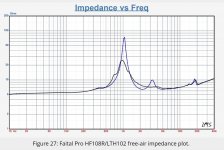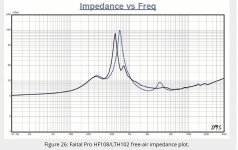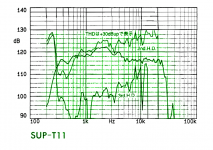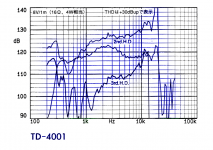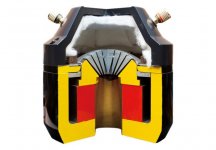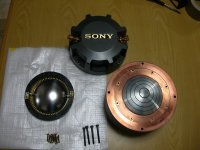Wonder how the Beyma compare with the 750 from Radian that is said to be good too in 1.4" CD size ?
I think Faital know what they are doing. Yes, higher Fs for the R version, so not the lowest possible crossing. On the other hand, the impedance curve in the passband is smoother than the non-R. The CSD of the R version is also slightly cleaner, according to the Audioxpress review.You may be right. The rear chamber may be set up for different diaphragm termination points. The one big thing i noticed on the HF108R is the higher resonant frequency. This is counterproductive for using the driver at the lowest practically possible xover points, as you would try to stay out of operating in the resoant areas of the curve. I dont believe the R version is more suited to hifi use based on the description given by Faital, as a heavier diaphragm is worse at reproducing higher frequencies based on its increased mass alone. Plus a driver that needs more non-linear EQ to flatten is usually going to have more problems in general.
Voice Coil Magazine did a brief comparison and review on both versions of HF108s, but didn't go into much detail on differences, as they felt there were more similarities than differences. I dont agree, but those who want to know can read it for themselves. There is some differenc in the HF breakup based on FR and spurious impedance peaks associated with the R version. Here's the link -
https://audioxpress.com/article/Tes...ession-drivers-coupled-with-LTH102-60-50-horn
Last edited:
I tried to do alot of homework chosing between the two versions of HF108s and came to the conclusion the non R was better suited to domestic or studio monitor use. The critical stuff I believe is the upper passband around 8k where the resonances start. The R has some breakup there as you can see on the impedance resonance. Thats an important area in the curve due to the inter aural resonance of the ear canal length and drivers with problems in this area sound rough and grainy to me when played louder. Many people don't exploit the full dynamic capabilities of a compression driver in a domestic setting, but I get pretty close while watching THD levels. I've listned to dozens of 1" exit HF drivers so far and the best by a mile is the regular HF108, especially how low it can be pushed. I dont agree with the VC test as a whole, mainly because Vance D never says anything bad about a driver even though it can be seen theres a clear issue with some.
Attachments
Last edited:
I have aluminum diaphragms on hand though I have not installed them. The swap would be very easy and I plan to try them out at some point.Thanks milezone, your description makes me want to try the CP755ND 🙂
I agree wholeheartedly with everything you said about Altec 288, they are very musical.
Have you tried both the titanium and alu diaphragms, I suppose they are interchangeable?
What horn/waveguide are you using, and how low can the Beyma's be used?
I am using a Ciare PR614. It is a great option crossed at 700hz. On a large horn the CP755NDs should play to 500hz with some equalization.
Another good 1" CD I really like for some applications is the Celestion CDX1-1430. The aluminum diaphragm with polymer surround are a very good mixture. Its probably the best dirver under $150 for HF clarity and extension. Haven't tried it lower than 2k though and it has a longer throat making it suitable for only specific WGs. On the right one though it sounds like a ribbon up top. Pretty underrated driver.
Is it far or close to the cdx1-1747 ? cause that one is rated below the BMS for less than 150 USD.
http://www.justdiyit.com/grand-comparatif-de-compressions-1-pouce/ (google translate is your friend)
http://www.justdiyit.com/grand-comparatif-de-compressions-1-pouce/ (google translate is your friend)
Hey just curious what beyma 15in your talking about and you said your using two on each side instead of one how far down do they play if you don't mind me asking would greatly appreciate itHi have the following drivers on hand with various horns and am comparing over the next few days/weeks for experimentation in 2 and 3 way configurations.
Beyma CP755ND
Beyma TPL200
Beyma CP22
BMS 4552
BMS 4591
Faital HF206
Faital HF1440
Faital HF108
I'm using a pair of 15" woofers with low mms cones in an open baffle configuration -- rated at 101db in proper enclosures. I will soon be able to bi-amp and experiment with different crossover points upon the arrival of some NCore amps which I've ordered.
The passive crossover I'm using at the moment is a 12db/oct two way at 1200hz with fixed attenuation settings.
My very preliminary finding thus far is that the CP755ND is outstanding. In a two way configuration it is more than one could ask for. It has an energy and clarity that I've seldom if ever experienced with loudspeakers, having owned and heard many top of the line offerings -- the most notable being vintage Tannoy Silver 12s, Soundlabs Electrostats, servo driven Acoustats, contemporary coaxial drivers, Apogee ribbons, Linkwitz LX521 etc.
I prefer the point source presentation of a two way horn system with a wide dispersion horn, to panels. In my experience thus far I prefer a wide horn angle compared to a heavily horn loaded presentation. The advantages in my experience are primarily a much more spacious soundstage at normal listening levels in a home size listening environment, and a nicer tonality.
I am curious to test the Radians, Celestions and TADs -- especially if the BMS 4591s in large radial horns with a supplementary tweeter shows promise and are advantageous over the CP755NDs. Contrary to what many claim on forums, I believe there may be an advantage to incorporating a higher crossover point than one might intuit, like 1200hz, if the woofer is suitable to cover more of the mid range.
I chose a 15" Beyma woofer intended for studio monitors with low qts. I like the presentation as is as I'm not a bass junky and prefer a presentation that is more musical versus impactful at the expense of detail in the mids and highs. These woofers measure far better than open baffle specific woofers like AE and the likes, and I figure if the need for more bass strikes I can experiment with equalization upon the arrival of the NCore amps.
In addition, the TPL200 is outstanding. It has a finesse in the upper registers that would probably put it in a class of the top tweeters available today. It lacks the incredible midrange energy and clarity of the CP755ND. Thus it is suitable for small scale studio monitors and hifi speakers though not as massive in presentation as the CP755ND. Both the TPL200 and the CP755ND are very smooth and non objectionable -- which is seldom the case with horns and compression drivers.
I use a single 15G40 per side and am planning to build an enclosure to house a pair. I also intend to experiment with some other drivers once I do. The 15G40 is good as is though. They are a low range driver though not a dedicated subwoofer driver. They play to ~flat to 100hz then start to roll off though much more gently than other similar drivers. Their bass performance is better than a pair of 15P80FeN drivers which I also have for example. The ladder are presumably better suited as a low/mid driver.
The TAD 4003s are presumably very nice though very rare. They are similar in many ways to the Altec 288s which were later branded and modified for greater power handling JBL drivers. These legendary drivers are all designed by Bart Locanthi. As an engineer with that sort of knowledge, time invested into a project, in an era without computers and a relatively large budget one typically gets it right the first time as was the case with the 288. The TADs are an evolution of the same architecture though more similar than different. The biggest distinguishing factor is the vapor deposition Beryllium diaphragm which is a far more advanced component than Truextent diaphragms or anything made today for that matter. The Radians are not remotely comparable. I am sure they sound good and impressive relative to other conventional speaker configurations -- the power handling specs for example imply they are more oriented for high output sound whereas the TADs would be a level of refinement that the Radians do not approximate in any capacity. Here are mediocre measurements of the aluminum version 951: https://audioxpress.com/article/tes...pression-driver-from-radian-audio-engineering.
Oof, the alu version is nasty, good thing that beryllium existsHere are mediocre measurements of the aluminum version 951: https://audioxpress.com/article/tes...pression-driver-from-radian-audio-engineering.
The TAD TD-4003,TD-2002 along with TL-1102 and 1601c was released in 1997. 11 years after Bart retired from TAD (1986). The TL-1801 and 1101H that has the same cone material, also can be attributed to Japanese engineers, but still very similar to the previous drivers.The TAD 4003s are presumably very nice though very rare. They are similar in many ways to the Altec 288s which were later branded and modified for greater power handling JBL drivers. These legendary drivers are all designed by Bart Locanthi. As an engineer with that sort of knowledge, time invested into a project, in an era without computers and a relatively large budget one typically gets it right the first time as was the case with the 288. The TADs are an evolution of the same architecture though more similar than different. The biggest distinguishing factor is the vapor deposition Beryllium diaphragm which is a far more advanced component than Truextent diaphragms or anything made today for that matter. The Radians are not remotely comparable. I am sure they sound good and impressive relative to other conventional speaker configurations -- the power handling specs for example imply they are more oriented for high output sound whereas the TADs would be a level of refinement that the Radians do not approximate in any capacity. Here are mediocre measurements of the aluminum version 951: https://audioxpress.com/article/tes...pression-driver-from-radian-audio-engineering.
The biggest differences in the CD's being the diaphgrams and phase plugs, and 'improved' magnets, this being the years the Cobalt crisis was going on and Alnico became expensive and difficult to come by, they naturally experimented with and used Neo magnets for the 4002 and 4003.
Last edited:
If you already have them. The JBL 2450/2445 Aquaplas diaphgrams does behave better then the stock alu ones in terms of resonances and breakups for a reasonable amount of money, if looking for a middle road.Oof, the alu version is nasty, good thing that beryllium exists
Also todays PA drivers are often more intended for highest possible power handling and maximum SPL. Some engineers do find diaphragm resonances and breakups useful to boost output spl, as a fair trade off to 'fidelity'. There is always the desire to manaufacture cheaper and cheaper, PA is also about weight savings, and more power handling often means more air exchange and looser tolerances in gaps etc to achieve so more effectively.
Which is not always desireable if your chasing the ultimate in fidelity and linearity. Where for example TAD and other more exotic drivers are chasing resonance free diaphragms, clean impulse responses, close tolerances etc. to a much larger degreee and by doing so sacrifices the power handling and robustness of design.
Everything has a tradeoff, and everything is designed to a price point for a intended purpose.
Last edited:
And lastly a rarity. A vintage, large format 2" Compression driver, with a aluminium diaphragm that behaves well compared with the TD-4001.Oof, the alu version is nasty, good thing that beryllium exists
The cutaway is of the modern version of it, made in Japan and sold for hmm interesting amounts of money, by G.T sound.
Using a 35 μm thick 4" alu diaphragm, with diamond shaped stamped surround like JBL. It also has unusally high amounts of copper in the motor, double shorting rings, copper covered top and a thin 'shorting' ring pressed on the voice coil, 4 slit phase plug. And 3,1kg of Alnico magnet with 2.0 T in the gap.
The Radian will take more power and go lower obviously, but if it is a better design depends on priorities.
Attachments
Nasty, really? How exactly do you find them nasty?Oof, the alu version is nasty, good thing that beryllium exists
I have the 950 with both original alu and truextent beryllium. I find the alu very nice sounding, warm and full bodied/weighty sound with surprisingly good top end extension. Beryllium is more transparent and detailed, but thinner and more clinical sounding.
The Yamaha JA6681B is another very nice driver with alu diaphragm, using copper/beryllium fingers for edge suspension.And lastly a rarity. A vintage, large format 2" Compression driver, with a aluminium diaphragm that behaves well compared with the TD-4001.
The cutaway is of the modern version of it, made in Japan and sold for hmm interesting amounts of money, by G.T sound.
Using a 35 μm thick 4" alu diaphragm, with diamond shaped stamped surround like JBL. It also has unusally high amounts of copper in the motor, double shorting rings, copper covered top and a thin 'shorting' ring pressed on the voice coil, 4 slit phase plug. And 3,1kg of Alnico magnet with 2.0 T in the gap.
I sold my TAD 4001's after getting these. More natural and relaxed sound, and very close in transparency.
True. Bart designed the TD4001 cds and 1601 woofers. The three major differences in comparing the cross sections of the 4001 and 4003 are a different variety of annular phase plug, shallower throat, and added volume of the chamber behind the diaphragm benefitted by the use of neo magnets. All of these are improvements over the 288, 2440, 4001 and ones which many contemporary drivers observe and implement to some extent. No doubt the 4003s are the cream of the crop. The Beyma CP755NDs which I am fond of feature a 2.2t flux density compared with a 2t flux density of the various TAD drivers mentioned. So while the TAD beryllium drivers are excellent, some contemporary drivers feature specs which are superior -- magnetic strength and physical density and the various factors effected by that. In addition some feel that a diaphragm with a mylar suspension like that used in the Beyma and also the Truextent is superior to a uniform material diaphragm like the vapor deposition TADs or stamped JBLs and Altecs.The TAD TD-4003,TD-2002 along with TL-1102 and 1601c was released in 1997. 11 years after Bart retired from TAD (1986). The TL-1801 and 1101H that has the same cone material, also can be attributed to Japanese engineers, but still very similar to the previous drivers.
The biggest differences in the CD's being the diaphgrams and phase plugs, and 'improved' magnets, this being the years the Cobalt crisis was going on and Alnico became expensive and difficult to come by, they naturally experimented with and used Neo magnets for the 4002 and 4003.
Last edited:
The 1747 Celestion has a polyimide diaphragm, a bit like the DE250 in some ways sound wise. I dont like the lower midrange on this driver due to the diaphragm material alone. The 1745 is pretty much the same motor, but has a PET diaphragm which sounds warmer than polyimide. I'm not a big fan of the way Celestion clamps the diaphragm edge. I had to sand down the back housing on my 1745s to stop the VC from buzzing at certain frequencies. The 1730 is a compact neo magnet version of the 1745.Is it far or close to the cdx1-1747 ? cause that one is rated below the BMS for less than 150 USD.
http://www.justdiyit.com/grand-comparatif-de-compressions-1-pouce/ (google translate is your friend)
The 1425 and 1430 has an alu diaphragm with polyester surround. Thats one reason why its so nice up top along with the smaller diameter VC, making it a good choice for a tweeter application. Some people have used it on larger horns with great success. I just like it in general because of its open and detailed top end. I believe it was designed for line array packaging, so its alot of driver in a small package. The drawback for me with this type of driver is the depth and offset in acoustic center on a typical WC.
Hi ChrisThe issue with any driver exit diameter is related to dispersing the output above a frequency which corresponds to a half wavelength of sound across the throat exit--the sound above these frequencies "beam". For a 2" driver, that's ~6800 Hz at room temperature. For a 1" driver, it's ~13500 Hz, so both have issues, just at different frequencies.
There is a fix for this: an in-throat acoustic lens that divides the throat diameter into smaller annular distances:
View attachment 1113042
In my subjective experience, this little 3D printed acoustic lens that slips in between the driver and the horn throat seems to solve that issue. I can now walk off axis at extreme angles to the K-402 centerline and the timbre of the sound doesn't change (i.e., above 6.8 kHz up to the limit of my hearing acuity--which probably is below 20 kHz at reasonable SPL).
This also creates a more realistic decay in-room while listening essentially on-axis. The extreme highs that are reflected off the walls, ceiling and floor sound like they should as if the real instruments or voices are playing in-person (subject to the limitations that the recording engineers placed on their recording via microphone choice and their placement, as well as in-line compression that's typically used).
Chris
Did you take any on/off axis measurements of this device?
To me it sounds a bit like black magic.
You were good up to this statement (quoted above), which, I don't know...really doesn't motivate me to answer. [In the future, I recommend leaving this sort comment off--if you really want an answer, as a courtesy to wider diyAudio community--not just the person of whom you ask the question.]To me it sounds a bit like black magic.
However, there was another gentleman on the forum that asked that question some time ago--and he asked more reasonably. I'll answer his question instead:
The following polar sonogram was generated using OmniMic from FRD files taken from REW measurements of a TAD TD-4002 on a K-402 horn in the horizontal axis at 10 degree increments. (Some here might know that the TD-4002 has a "snout" that increases the throat diameter from 1.5 to 2 inches, thus increasing the distance of the acoustic center of the driver to the horn's throat entrance. The effect of this lengthening of the distance of the driver's throat entrance is to increase the beaming of high frequencies above 6.8 kHz without a corrective lens. )
Below, you will see the polar coverage out to ~14 kHz before the beaming becomes dominant subjectively (which BTW was the advertised performance of the throat lens by the guy that came up with the device). This increase in polar coverage between 6.8 kHz and ~14 kHz places the TAD TD-4002/K-402 on par with a good 1" driver on a 1" horn--without said lens.
Here is the on-axis SPL and phase plot of those measurements (no smoothing):
and the total group delay and excess group delay of the same measurement (on-axis, no smoothing):
This increase of the polar coverage above 6.8 kHz is what I was subjectively reporting on. This is very audible and greatly increases the subjective performance of the loudspeakers, especially listening off-axis while walking from side wall to side wall in my listening room.
I've got these throat diverging lenses in my front three loudspeaker array (i.e., TD-4002 Jubilees left and right front corners, bi-amped BMS 4592 ND K-402-MEH in the center location--in my 5.2 loudspeaker array setup).
Chris
- Home
- Loudspeakers
- Multi-Way
- Best Compression Drivers today 2022?
